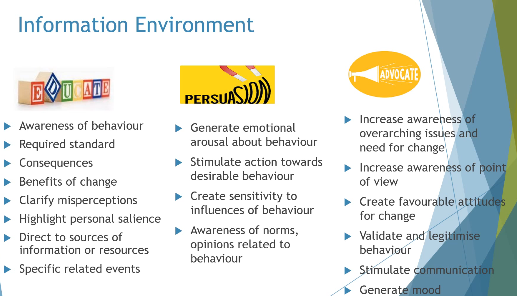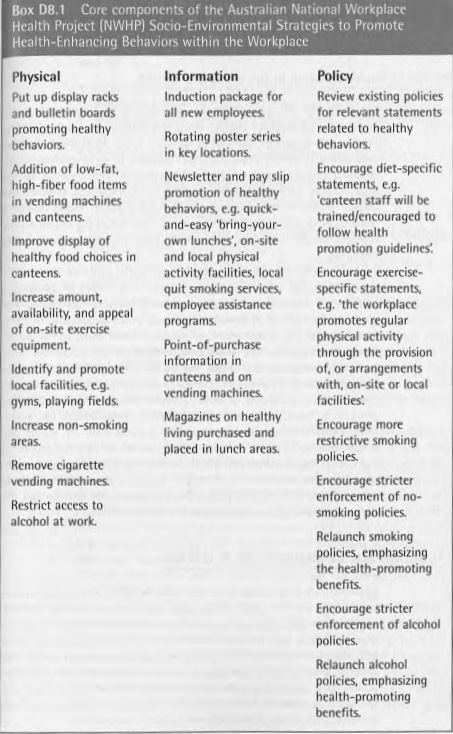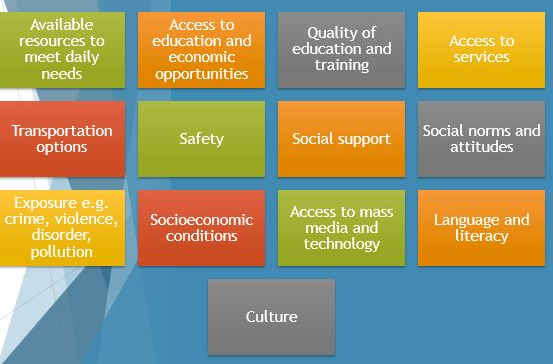Topic 9: Population Level Behaviour Change
population-level approaches aim to understand/change average levels of behaviour in large numbers of people by focusing on awareness and the context of the behaviour. aim to motivate and support people to understand the consequences of behaviour, feel positive about the benefits of behaviour change, recognise how social factors and physical contexts affect behaviour, and plan change and explicit coping strategies.
This can include changing aspects of the social and physical environment, BUT only those that relate to that specific person (i.e., changing the social networks and/or environment of that person only).
Advantages of Individual-Level Approaches
allow for intervention to be tailored to the person and fit their specific needs
have potential to produce a large magnitude of individual change
are relationship based
Disadvantages include
require identification and active engagement with people
limited reach
risk individual blaming and stiignatisation (by focusing on the person as the main influence of the behaviour)
de-emphasise the contextual factors that can influence the behaviour
n contrast, population-level approaches aim to change average levels of behaviour in a community by targeting awareness and the associated context and needs.
Population-level approaches aim to improve aspects of the setting and culture which support desired behaviour, reduce barriers to desired behaviour, and/or increase barriers to undesired behaviour.
interventions at the population level can include
introducing community wide programs
restructure of physical environment
enable access to opportunities for the behaviour
providing behaviour relevent resources
use of mass information
economic strategies
economic strategies
policies and regulation
advantages of populaion level approaches include
does not require active participation
large reach
move beyond individual blaming
potential for radical and powerful change
acknowledge upstream influences on behaviour
Limitations of population level approaches include
paternalistic? compromise individual autonomy
not seen as salient among people in need
complex and require extensive planning, commitment, resources, coordination, stakeholder liaison
high level of uncertainty
low level of control over intervention activities
loing time for implementation and change
small magnitude of individual level change
ecological models of behaviour: focus on the inter-relationships between people and their physical and sociocultural environment; also acknowledge the broader environment and policy as influences on behaviour
 Multiple influences of behaviour
Multiple influences of behaviour
Different levels of influence and their importance vary depending on the type of behaviour and the context
sociocultural and physical influences may apply to more than one level - may be relevant to organisations and the community
Environmental contexts are significant influences on behaviour
Behaviours may be predicted more accurately from the situations people are in than from the individual characteristics of the person. The physical and social situations in which behaviour occurs can promote and/or restrict behaviour.
Contexts can also impact on individual and interpersonal influences on behaviour.
Influences on behaviour interact across levels. e.g. , attitudes may influence reactions to environmental cues and opportunities. e.g. social support may influence knowledge and skills.
Ecological models should be behaviour specific: Ecological models are most useful when they focus on a specific behaviour. Environmental and policy influences are often behaviourally specific
Multi-level interventions should be most effective for behaviour change: As there are multi-level influences on behaviour, multi-level interventions should be more effective than single-level interventions.
 Using the information Environment to change behaviour
Using the information Environment to change behaviour
we can educate, persuade, train, coerce or advocate
provides information about desired or undesired behaviour
educational approach can provide awareness, standard, consequence, benefits for change ect.
persuasion: generate emotional arousal about the behaviour
advocate: increase awareness of overarching issues

shaping knowledge: instruction on how to perform the behaviour
natural consequences: information about health consequences
natural consequences: anticipated regret
natural consequences: salience of consequences
Targeting the Physical Environment
The physical environment includes the presence, characteristics and location of facilities and resources relevant to the behaviour, and may focus on attributes such as e.g., availability, accessibility, functionality, structure, quality.
Different components of the physical environment include
the natural environment e.g., green/blue space, open space, natural light, temperature, weather
the built environment e.g., buildings, structures, facilities
physical attributes of settings e.g., size, colour, complexity
housing/community design e.g., multiple occupancy dwellings, street connectivity, mixed purpose development, density
exposure e.g., pollution, sanitation
physical barriers e.g., low accessibility
aesthetics e.g., cleanliness, attractiveness
targeting the economic and policy environment
This includes costs, procedures, rules and regulations relevant to the behaviour.
Economic environment: costs/affordability of behaviour
i.e. taxes, fines to reduce - financial coercion
discounts, subsidies, rebates, financial rewards to increase - financial enablement
Policy and legislative environment: policies, procedures, rules, regulations that are relevent to behaviour
national, state, local, or organisational/setting
workplace policies:

Population-level approaches to behaviour change which use the information, physical, economic or policy environment can target specific settings such as
education settings e.g., schools, universities
workplaces
service settings e.g., GP practices, hospitals, community clinics
community contexts e.g., neighbourhoods
Reading
the physical environment: includes the presence, characteristics, and location of facilities relevant to the behaviours being targeted
information environment: sources of information and education that are relevant to understanding and influencing the desired behaviours
policy environment: policies, procedures, rules, regulations relevant to the behaviour
social environment: subjective norms, social connections, and social support provied by a range of people
Schools are a well-established area for behaviour change; behaviours can reach children, adolescents, and their families
Barriers includes, standard curriculum, require support of educational system, school admins, teachers, parents and wider community
 an example of targetting at a range of levels
an example of targetting at a range of levels
targetting the workplace and work organisations
programs focused on characteristics in the workplace that are relevant to preventing harm and promoting health
barriers:
productivity loss is perceived
Upstream social determinants refer to the conditions and circumstances in which people are born, grow up, learn, work play and live, relevant to others
upstream social determinants reflect distribution of power, wealth, and resources
